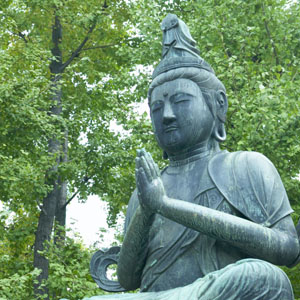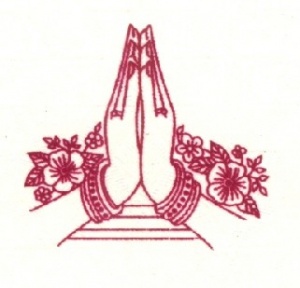The Indian way of greeting, Namaskar (Namaste, Vanakkam, Namaskaram, Swagatham, etc) by joining the hands together is can be seen around the world. The joining of hands at the level of the heart symbolically signifies the greeting from the Heart/Soul. Both hands join together at the palms straight across the chest signifies a salute from the Soul, or a welcome from the Heart.
The two palms are placed together in front of the chest and the head bows whilst saying the word Vanakkam/Namaste. This greeting is for all, that is, both younger and elder people. This is understood as prostration but it actually refers to paying homage as we do today when we greet each other with a Vanakkam/Namaste.
Vanakkam or Namaste could be just a casual or formal greeting, a cultural convention or an act of worship. However there is much more to it than meets the eye. In Sanskrit namah + te = Namaste. It means - I bow to you - my greetings, salutations or prostration to you. Namaha can also be literally interpreted as "na ma" (not mine). It has a spiritual significance of negating or reducing one's ego in the presence of another.
The real meeting between people is the meeting of their Souls. When we greet another, we do so with Vanakkam/Namaste, which means, "May our soul's meet" indicated by the folded palms placed before the chest. The bowing down of the head is a gracious form of extending friendship in love and humility.
There are other interpretations of the symbolism, like the right hand representing higher nature and the left, lower nature, and the joining signifying the meeting of the two natures to form a single mind of the person. Some others interpret it as a greeting from one mind to another also. Some others say that it signifies, “I bow to the God in you” or “I bow to you” or “My Soul bows to your Soul” – Like this, the interpretations for the symbolism of the NAMASKAR is different for different regions and different beliefs.
The Spiritual meaning is even deeper. The life force, the divinity, the Self or the GOD in me is the same in all. Recognizing this oneness with the meeting of the palms, we salute with head bowed the Divinity in the person we meet. That is why sometimes, we close our eyes as we do Vanakkam/Namaste to a revered person or the GOD - as if to look within.
In Yogic Science, the five fingers represent the five elements – this is best expressed in Mudras. Mudras are very common in various dance systems like Bharatha Natiyam, Kathakali and Kuchipudi. One can find various Gods and Goddesses assuming some mudra or the other. Even Lord Jesus Christ is often depicted in India with his right hand in Pran Mudra. In Mudras, Namaste or Vanakkam or Namaskar is known as Anjali Mudra. Anjali Mudra increases the peace and poise of the person practicing it.
The significance of the five fingers is that Thumb stands for Fire energy (which is why we have the thumbs up sign for success or victory), Index finger stands for Air energy, Middle finger stands for Space/Sky, the Ring finger stands for Earth energy (another reason for putting the ring on this finger) and the Little finger stands for Water energy.
The true meaning of Namaskar is the neutralization of all the energies by bringing both the hands together so that each finger of one hand touches the corresponding finger of the other hand, to denote that the person does not have any powerful positive/negative energies to affect the other person. Thus, it is a true gesture of friendship and welcome.
Vanakkam/Namaste to all the visitors, followers and knowledge seekers! :)
1. http://www.lankanewspapers.com/news/2007/7/16554_space.html
2. http://omsmusings.wordpress.com/
2. http://omsmusings.wordpress.com/




No comments:
Post a Comment